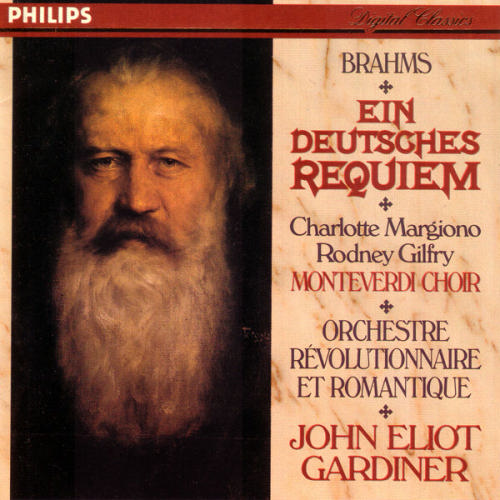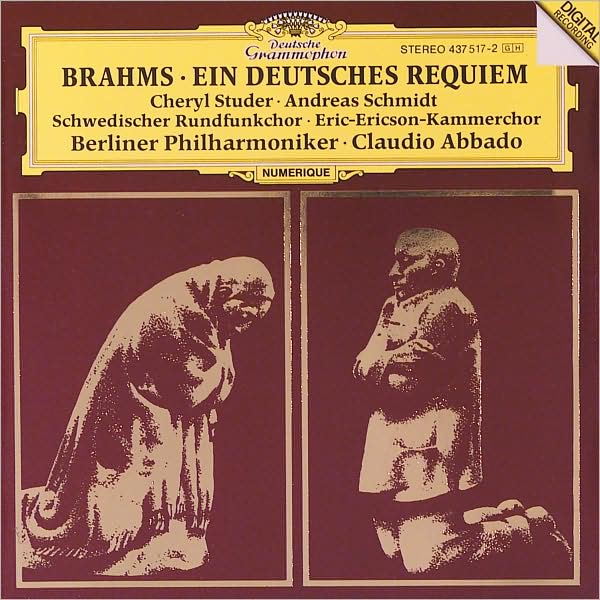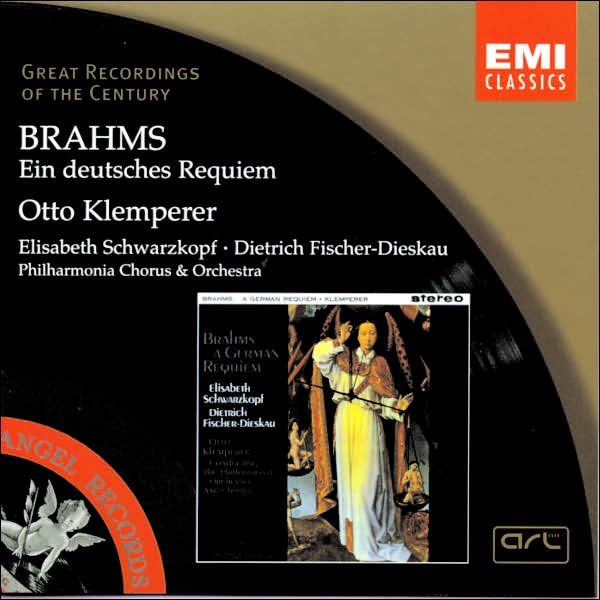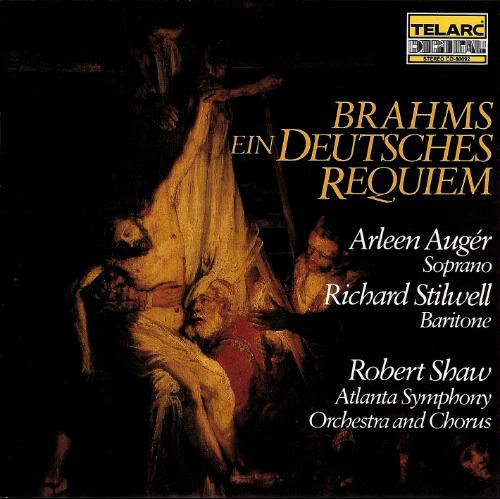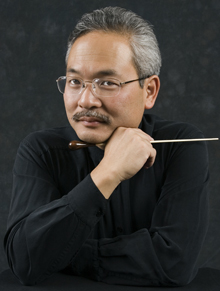Johannes Brahms Ein Deutsches Requiem (A German Requiem), Op. 45
A wonderful embarrassment of riches faces those looking to procure a recording of Brahms' Ein Deutsches Requeim for their collection. This monument of Brahms' oeuvre has always been well represented on disc, and from the continuous output of outstanding versions, it looks as though the trend will happily continue.
John Eliot Gardiner
Stunning it its clarity, tautness, drama, polished playing and singing, and
overwhelming musicality is John Eliot Gardner's 1990 recording with the
Monteverdi Choir and the Orchestre Révolutionnaire et Romantique
(Philips 432 140-2). One of two currently available versions using period
instruments, textures are cleanly etched and highlighted. The
lighter tone of gut-strung violins, short Viennese oboes, and small, bright
timpani played with hard sticks rather than soft, fuzzy mallets, contribute
to the clarity. Still, there is no lack of weight and strength here.
The Choir, augmented for this recording to a total of 48 members, sings
impeccably. Perfect diction, intonation, phrasing, and a wonderfully
varied tonal palette are always hallmarks of the ensemble—and are in
evidence here as much as ever.
Gardiner's unwavering attention to Brahms' scrupulous dynamic and phrasing markings is admirable, and the results point up the composer's architectural genius.
Glowing singing by soloists
Rod Gilfry and Charlotte Margiono round out this first-rate recommendation.
By comparison, the other "period instrument" version, conducted by
Roger Norrington (EMI CDC 7 54658 2), is a disappointment. Though clean
and tight, with some beautiful singing and playing, it is noticeably lacking
in drama and impact—the results are more "Brahms-Lite-ish"—like a Bach
cantata on steriods.
Claudio Abbado
Of the "big-band" versions available, Claudio Abbado's newest with the Berlin
Philharmonic and the Swedish Radio Chorus and Eric Ericson Chamber Choir
(Deutsche Grammophon 437 517-2) is a winner.
Taken from live concerts, there are the expected minor glitches:
audience coughs, occasional end-of-word consonants
that are not perfectly lined up, etc.
But the overall impact and beauty of the playing and singing is top-drawer.
Cheryl Studer is a radiant soprano
soloist, and Andreas Schmidt's baritone contribution is admirable for its
warmth and depth--though the real star of the recording is still the choir.
Through the years, the DG engineers seem increasingly better able to cope
with the odd flatness of Berlin's Philharmonie as a recording venue, and the
recorded sound for this release is full and rich with no lack of detail.
Otto Klemperer
Otto Klemperer's 1962 reading with the Philharmonia Chorus and Orchestra has long been a favorite (EMI CDC 7 47238 2). The chorus does not have the polish and unanimity of tone production of several more recent versions, but the singing is still musical and convincing. The solo singing is unmatched, as would be expected with Elisabeth Schwarzkopf and Dietrich Fischer-Dieskau. Though Penguin characterizes the tempi as "consistently slow," they are actually rather in the middle ground of what is available, with Norrington at the fast end and Rilling at the opposite. The digital transfer is a success, and though the sonics do not sound brand-new, they compare favorably with more recent versions.
Robert Shaw
Robert Shaw recorded the Requiem in 1984 for Telarc (Telarc CD-80092) as part of his traversal of the great choral/orchestral masterworks for that label. Both singing and playing are excellent, and tempi are generally even more expansive than Klemperer's--though there is still the tautness and precision necessary to bring off the work's more complex contrapuntal sections. Arleen Augér is pure and poised as soprano soloist. The only minor quibble with this offereing is that the chorus is placed quite far back in the recorded perspective, detracting from the listener's perception of the ensemble's lyric diction.
Other recordings
There are many other highly recommended recordings, and the listener really
can't go wrong with any of several versions.
Sinopoli's red-blooded reading with the Prague Philharmonic Chorus and the Czech Philharmonic is dramatic and well recorded (Deutsche Grammophon 429 486-2).
Either of Karajan's later two versions (EMI CDM 7 69229-2 from 1977 or Deutsche Grammophon 431 651-2 from the early 1908's) is good.
And although both feature the Vienna Singverein, the choir seems in better voice on the earlier EMI version.
Haitink conducts a very persuasive performance (Philips 432 038-2)
with the Vienna State Opera Chorus and the Vienna Philharmonic. Tempi are
very slow and Penguin praises the "rapt quality in this glowing
performance."

